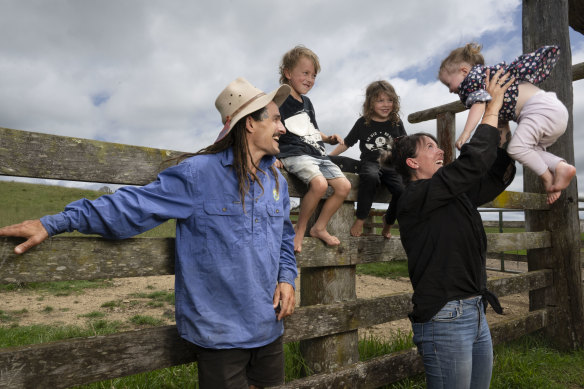
The idea is that this type of grazing helps the land recover from historic over-farming, which makes it more productive. The extra plant growth also captures carbon and channels it into the soil, which is providing a lucrative new income stream for farms, including Wilmot.
“As the whole story about climate and biodiversity increased, that’s the moment when I realised that actually what we were doing here could be of significance way beyond agriculture,” MacLeod says, as 350 farmers gather nearby to learn from Wilmot and other landholders at the property’s annual field day.

Farmers at the Wilmot Field Day learn how things are done at the property.Credit: Janie Barrett
MacLeod wants to create a giant “carbon sink” out of Australia’s agricultural land, where farmers would change their land management practices and suck up so much carbon into their soil they could offset their own emissions, as well as those of other businesses. Macdoch’s latest enterprise, Atlas Carbon, advises farmers on how to do that, and will manage their projects – for a commission.
Wilmot made headlines in 2021 when it sold $500,000 worth of carbon credits to Microsoft on the back of carbon it had built up in its soil. The deal stirred up controversy among scientists, who questioned the farm’s reported carbon findings, but the money involved made farmers sit up and take notice.
Scientists agree soil can store carbon, but there is heated debate about how much it can hold and how to test it accurately to ensure any gains leading to carbon credits are the result of land management, rather than natural processes.
The federal government also believes farmers need to do more than just offset their emissions – they need to cut them too. The sector is responsible for about 18 per cent of Australia’s emissions, largely through the use of nitrogen in fertilisers and the production of methane from livestock.
MacLeod says offering soil carbon credits is a way to get farmers on board with regenerative agriculture and to change farming practices, regardless of the many unknowns in the area, and addresses emissions by saying technology will eventually work that one out.
Charles Sturt University professor in applied ecology Geoff Gurr says agriculture in Australia is not sustainable, and fixing the ecosystems upon which farmers rely is a “no-brainer” – for the environment and for individual businesses.
“It’s a thing that we must do,” he says. “Where it starts to get complex is that regenerative agriculture means different things to different people. And the other layer of complexity is that many people, and especially landholders … have a sense of stewardship and pride in the way that they practise their agricultural management.

Stuart and Amber McWilliam with their children Hendrix, Nix and Amber, travelled from Laggan, near Crookwell, for the field day.Credit: Janie Barrett
“It might be using methods handed down through the generations in that family, or it might be that the landholder has gone to university and studied agriculture, and they are practising what they perceive as still state-of-the-art management.
“So when you talk to people about regenerative agriculture, passions can run hot and people can get a little protective of what they’re doing.”
The farmers at the Wilmot field day, however, are largely the converted. Laggan beef farmer Stuart McWilliam, who drove 10 hours with his wife and three children to attend the event, says most of his neighbours near Goulburn are still farming traditionally, but he was eager to embrace the regenerative methods championed at Wilmot when he started out four years ago.
Loading
“The mass use of chemicals in agriculture, and the mindset that you’ve got to spray a paddock out to kill everything to grow one specific thing, didn’t sit well with me,” he explains. “There’s a way to farm incorporating the environment, not trying to control it.
“I was an arborist for 10 years – I spent 10 years cutting trees down. This is my chance to correct things and do some good for the environment.”









 Add Category
Add Category